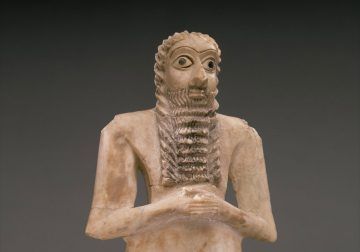Ed Simon at berfrois:
 Art historian Jean M. Evans (the current Chief Curator and Deputy Director of the Oriental Institute) writes in The Lives of Sumerian Sculpture: An Archeology of the Early Dynastic Temple that the “eerie effect of the enlarged eyes… has often arisen as a question. These eyes are perplexing.” Several hypotheses have been tendered over the decades as to why the Tal Asmar figurines, and other Sumerian votive statues, have this distinctive characteristic. Wide eyes, especially those absurdly large ones on these idols, could convey an emotion of surprise, or of ecstasy, or pupil-engorged intoxication. Evans gives several examples of modern interactions viewers have had with the figurines, quoting the American painter Willem de Kooning who commented that the Metropolitan Museum of Art had a cache of Sumerian statues with “huge staring goggle eyes” that were “wild-eyed,” and the psychologist George Frankl writing in The Social History of the Unconsciousness that these spheres of obsidian and opal convey a “sense of awe and apprehension which obviously indicated the anxiety those people felt in the presence of the gods.” Regardless of the intent (or multiple purposes) of the statues’ creators, Evans makes the point that the artworks have become “the subjects and objects of gaze.” Consider the first of these functions when deciding why the creatures’ pupils are so wide–it’s because they’re looking at you.
Art historian Jean M. Evans (the current Chief Curator and Deputy Director of the Oriental Institute) writes in The Lives of Sumerian Sculpture: An Archeology of the Early Dynastic Temple that the “eerie effect of the enlarged eyes… has often arisen as a question. These eyes are perplexing.” Several hypotheses have been tendered over the decades as to why the Tal Asmar figurines, and other Sumerian votive statues, have this distinctive characteristic. Wide eyes, especially those absurdly large ones on these idols, could convey an emotion of surprise, or of ecstasy, or pupil-engorged intoxication. Evans gives several examples of modern interactions viewers have had with the figurines, quoting the American painter Willem de Kooning who commented that the Metropolitan Museum of Art had a cache of Sumerian statues with “huge staring goggle eyes” that were “wild-eyed,” and the psychologist George Frankl writing in The Social History of the Unconsciousness that these spheres of obsidian and opal convey a “sense of awe and apprehension which obviously indicated the anxiety those people felt in the presence of the gods.” Regardless of the intent (or multiple purposes) of the statues’ creators, Evans makes the point that the artworks have become “the subjects and objects of gaze.” Consider the first of these functions when deciding why the creatures’ pupils are so wide–it’s because they’re looking at you.
more here.
